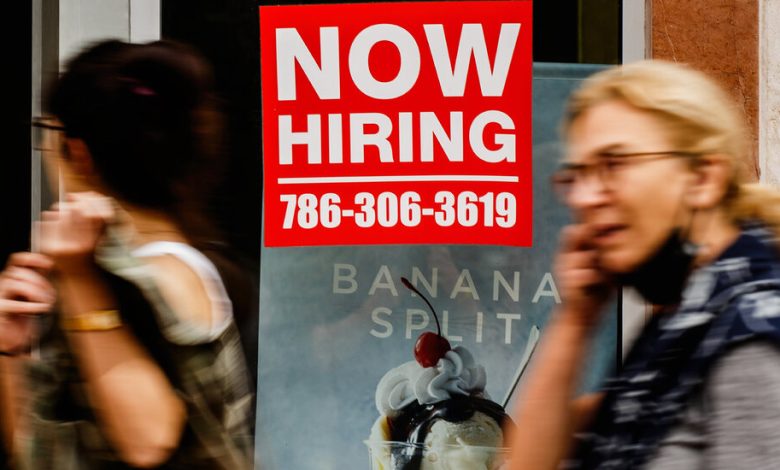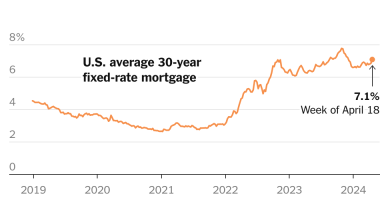A Key Measure of Wages Showed Moderation at the End of 2022

A measure of pay and benefits that the Federal Reserve has been watching closely amid a strong labor market rose less than expected at the end of 2022, fresh data showed Tuesday.
The Employment Cost Index climbed 1 percent in the final quarter of 2022 versus the prior three months, more slowly than the 1.1 percent economists expected and a slowdown from the previous 1.2 percent reading.
The data will probably reaffirm to central bankers that the economy and labor market are cooling, which could help inflation to return to normal over time. While wage gains are still faster than normal, the moderation could help central bankers to feel comfortable as they adjust interest rates less aggressively than they did throughout 2022.
Inflation F.A.Q.
What is inflation? Inflation is a loss of purchasing power over time, meaning your dollar will not go as far tomorrow as it did today. It is typically expressed as the annual change in prices for everyday goods and services such as food, furniture, apparel, transportation and toys.
What causes inflation? It can be the result of rising consumer demand. But inflation can also rise and fall based on developments that have little to do with economic conditions, such as limited oil production and supply chain problems.
Is inflation bad? It depends on the circumstances. Fast price increases spell trouble, but moderate price gains can lead to higher wages and job growth.
How does inflation affect the poor? Inflation can be especially hard to shoulder for poor households because they spend a bigger chunk of their budgets on necessities like food, housing and gas.
Can inflation affect the stock market? Rapid inflation typically spells trouble for stocks. Financial assets in general have historically fared badly during inflation booms, while tangible assets like houses have held their value better.
The employment cost measure picked up by 5.1 percent on a yearly basis, close to the 5 percent reading in the previous quarter’s report. In the decade leading up to the pandemic, the index averaged 2.2 percent yearly gains, underscoring the continued rapidness of today’s pace. But a measure of private sector wages excluding incentives, which economists see as a particularly good indicator of labor market tightness, slowed slightly.
Fed officials are closely watching the labor market — and wages in particular — as they try to gauge how much further they have to go in their campaign against stubbornly high inflation. While goods price increases tied to supply chain snarls are beginning to fade, central bankers are worried that rapid pay gains could keep services costs rising rapidly. Labor is a big expense for service companies, like hotels and restaurants, and firms might pass higher wage costs on to customers in the form of higher prices. Bigger paychecks could also help sustain consumer demand, keeping pressure on prices.
The fresh data on pay comes on the eve of the Fed’s next interest-rate decision, which will be announced on Wednesday. Central bankers are widely expected to raise rates by a quarter of a percentage point, after raising them by three-quarters of a point per meeting for much of 2022 and by half a point at their last gathering, in December.
The new adjustment would push rates up to a range of 4.5 to 4.75 percent. The question now is how many more moves the Fed will make — and how long policymakers will hold interest rates at a high level.
Understand Inflation and How It Affects You
- Federal Reserve: Federal Reserve officials kicked off 2023 by grappling with a thorny question: How should central bankers understand inflation after 18 months of repeatedly misjudging it?
- Social Security: The cost-of-living adjustment, which helps the benefit keep pace with inflation, is set for 8.7 percent in 2023. Here is what that means.
- Tax Rates: The I.R.S. has made inflation adjustments for 2023, which could push many people into a lower tax bracket and reduce tax bills.
- Your Paycheck: Inflation is taking a bigger and bigger bite out of your wallet. Now, it’s going to affect the size of your paycheck in 2023.
Steeper borrowing costs deter consumers from making big purchases and businesses from expanding, which can slow the economy and weaken the labor market. Fed officials are hoping that they can cool the economy by just enough to allow supply and demand to come back into balance — causing inflation to moderate — without causing a punishing recession. But they have been clear that they are willing to accept some pain to bring price increases back under control.
And they have underlined that they think the labor market needs to slow down to put inflation on a more sustainable path.
“We want strong wage increases,” Jerome H. Powell, the Fed chair, said at his last news conference in December. “We just want them to be at a level that’s consistent with 2 percent inflation,” he said, referring to the Fed’s target inflation rate.
For now, America’s rate of price increases remains much faster, at 5 percent.
Mr. Powell will give another news conference on Wednesday, after the release of the Fed’s rate decision at 2 p.m. Eastern.



